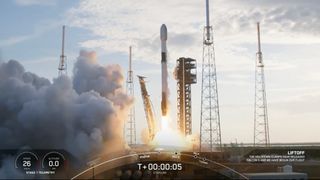Liftoff occurred at 6:40 p.m. ET today (April 18).
SpaceX launched its 40th mission of the year this evening (April 18).
A Falcon 9 rocket carrying 23 of the company's Starlink internet satellites lifted off from Cape Canaveral Space Force Station in Florida today at 6:40 p.m. EDT (2240 GMT).
The Falcon 9's first stage came back to Earth about 8.5 minutes after launch as planned, making a vertical landing on the SpaceX droneship A Shortfall of Gravitas, which was stationed in the Atlantic Ocean.

It was the seventh launch and landing for this particular booster, according to a SpaceX mission description. Two of the rocket's previous six flights sent astronauts to the International Space Station — the private Ax-2 and Ax-3 missions, which launched in May 2023 and January of this year, respectively.
The Falcon 9's upper stage, meanwhile, will continue hauling the 23 Starlink satellites toward low Earth orbit this evening, ultimately deploying them there about 65 minutes after liftoff.
Twenty-seven of the 40 orbital missions that SpaceX has launched so far in 2024 have been devoted to building out the Starlink megaconstellation. That network is already huge: It currently consists of more than 5,760 operational satellites, according to astrophysicist and satellite tracker Jonathan McDowell.
The 40-launch tally does not include the March 14 liftoff of SpaceX's Starship megarocket, which the company is developing to take people and cargo to the moon, Mars and beyond. Starship reached orbital velocity during that mission, which was the vehicle's third test flight overall.
Editor's note: This story was updated at 7:26 pm ET on April 18 with news of successful launch and rocket landing.


 DogeHome
DogeHome Crypto News Land
Crypto News Land U_Today
U_Today The Bit Journal
The Bit Journal BlockchainReporter
BlockchainReporter Optimisus
Optimisus






















